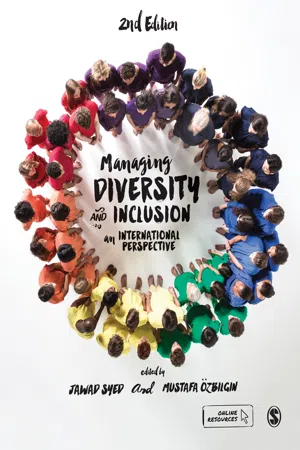
Managing Diversity and Inclusion
An International Perspective
- 464 pages
- English
- ePUB (mobile friendly)
- Available on iOS & Android
About this book
Written and edited by leading experts in the field, this authoritative account sets UK and European practices firmly within a global context. It offers an in-depth and contextual account of enduring, contemporary and cutting edge theories and approaches to diversity and inclusion management.
With workforce demographics changing rapidly, high-profile cases of discrimination in the news and new legislation coming into force, it is more crucial than ever that organisations understand and effectively manage workplace diversity – not only to increase business outcomes, but to create an inclusive workplace in a socially responsible manner.
This second edition includes an engaging new chapter on social class and diversity, as well as a range of new mini case studies on contemporary issues and themes such as intersectionality and autism employment.
Packed with learning features to encourage critical analysis and help you link theory to real-world practice, Managing Diversity and Inclusion offers an in-depth and contextual account of enduring and cutting edge discussions and approaches to diversity and inclusion management.
Frequently asked questions
- Essential is ideal for learners and professionals who enjoy exploring a wide range of subjects. Access the Essential Library with 800,000+ trusted titles and best-sellers across business, personal growth, and the humanities. Includes unlimited reading time and Standard Read Aloud voice.
- Complete: Perfect for advanced learners and researchers needing full, unrestricted access. Unlock 1.4M+ books across hundreds of subjects, including academic and specialized titles. The Complete Plan also includes advanced features like Premium Read Aloud and Research Assistant.
Please note we cannot support devices running on iOS 13 and Android 7 or earlier. Learn more about using the app.
Information
Part I Concepts
Part I Contents
- 1 Social and psychological perspectives on diversity (Lilian Otaye-Ebede and Loliya Akobo) 15
- 2 Leadership and diversity management in a global context (Clifford Lewis and Ahu Tatli) 42
- 3 Policy and practice of diversity management in the workplace (Darren T. Baker and Elisabeth K. Kelan) 81
1 Social and Psychological Perspectives on Diversity
Intended learning outcomes

- Define the concepts of equality, diversity and inclusion from multiple perspectives
- Understand the key sociological and psychological concepts of diversity
- Explain the dominant social psychological theories utilised by scholars in understanding diversity
- Discuss cultural diversity and its practices in Africa
- Identify good diversity practice initiatives within organisations
Introduction
What is ‘diversity’?
Historical underpinning concepts
Table of contents
- Cover
- Half Title
- Acknowledgements
- Title Page
- Copyright Page
- Contents
- Detailed Contents
- About the Editors and Contributors
- Foreword to the First Edition
- Acknowledgements
- Guided Tour of the Book
- Online Resources
- Illustration List
- Table List
- Sidebar List
- Introduction Understanding and Managing Diversity and Inclusion in the Global Workplace
- Part I Concepts
- 1 Social and Psychological Perspectives on Diversity
- 2 Leadership and Diversity Management in a Global Context
- 3 Policy and Practice of Diversity Management in the Workplace
- Part II Dimensions of Diversity
- 4 Gender Equality in the Workplace
- 5 Belonging Race, Intersectionality and Exclusion
- 6 Age Diversity Concepts, Strategies and Cases
- 7 Disabled People in the Workplace
- 8 Religious Diversity in the Workplace
- 9 Sexual Minorities in the Workplace
- Part III Future of Diversity Management
- 10 Work–Life Balance
- 11 Intersectionality in the Workplace
- 12 Social Class and Diversity
- Conclusion Future of Diversity Management
- Glossary
- Index